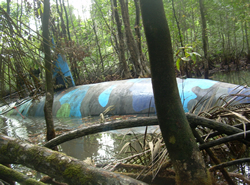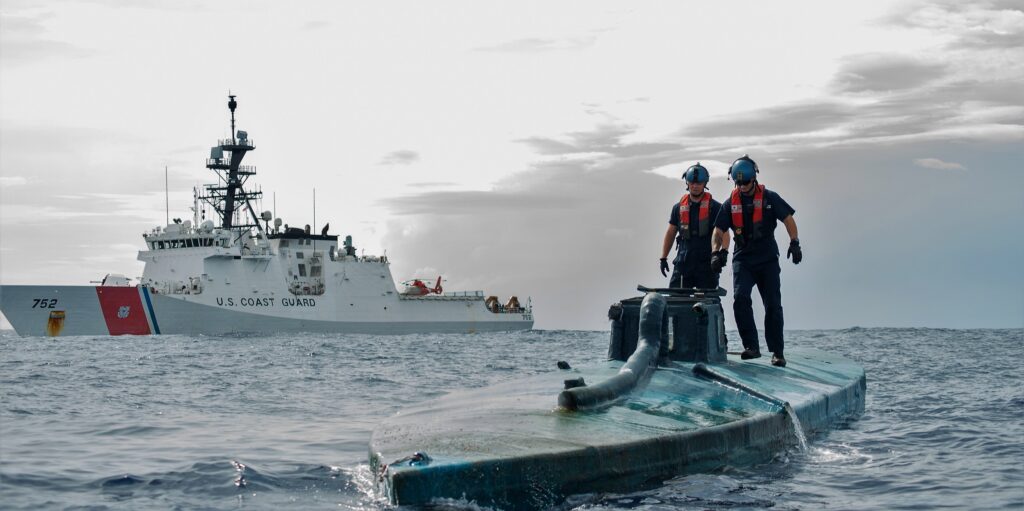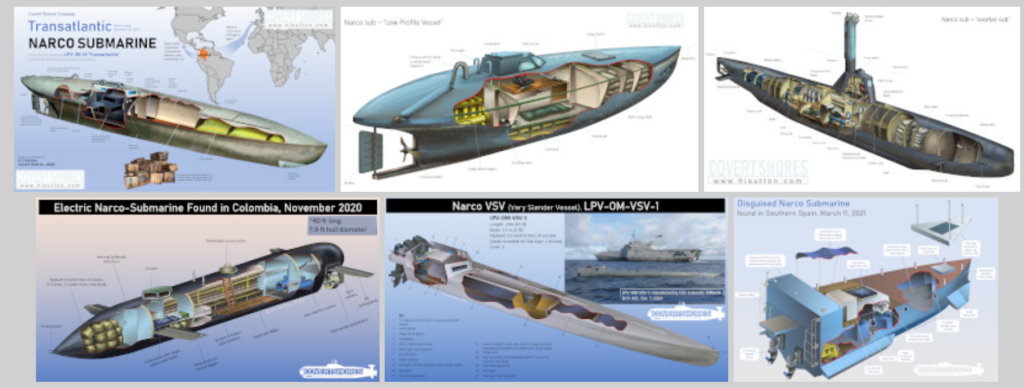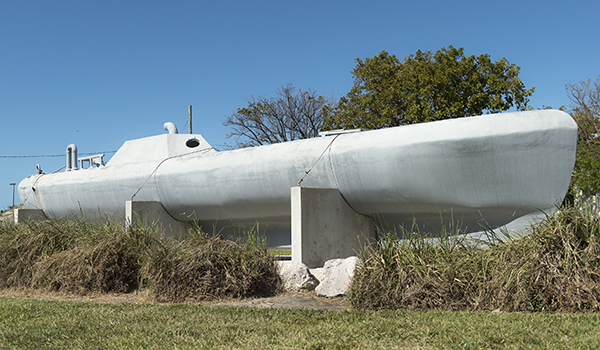The lowdown on Colombian narco-subs

Narco-subs are back in the news in March 2023 with the capture of two clandestine craft, one in the Colombian Pacific with two tons of cocaine – and two bodies – on board, and another found empty in an estuary by Spain’s Atlantic coast.
Here’s some questions and answers on the world of underwater smuggling.
For other Colombian Conflict stories check out my posts: Colombia’s Cocaine Conflicts 2023, Killed by the FARC in the Darien Gap, It’s the (Narco) Economy, Stupid and Zero Zero Zero review
Sounds fascinating, but are these proper submarines?
Most ‘narco-subs’ are actually boats, according to naval expert HI Sutton. On his website, he explains Colombian drug traffickers use ‘LPVs’, Low Profile Vessels, a kind of home-made stealth craft designed to float very low in the water making it invisible to radar.
The semi-submersible captured in March 2023 by the Colombian navy was 15 meters long and loaded with 2,600 kilos of cocaine, but powered by three large outboard motors which only work on the surface.
So not really ‘subs’ then?
Proper drug submarines do exist, but are much rarer – or harder to detect.
Some of these ‘FSVs’ (Fully Submersible Vessels) rely on a snorkel tube to bring air to the diesel motor, and have a conning tower, periscope and air conditioning, such the Kevlar ‘super sub’ found close to the Ecuador-Colombia border in 2010.
In 2020 an electric narco-sub with ten tonnes of batteries and room for six tonnes of cocaine was confiscated in Timbiquí, Cauca. But the most headline-grabbing narc submarine – and a proper big one at 46 meters – was found surprisingly far from the sea.
Back in 2000, a police raid in Facatativá, a town close to Bogotá, discovered the steel sub being built in a nondescript warehouse with help from Russian technicians. If ever launched it could have dived to 100 meters and carried 200 tonnes of cocaine a distance of 2,500 kilometers.
Why would anyone build a submarine in Bogotá?
Good question. Two and a half kilometers above sea level is not the obvious place to build a sea-going vessel. Unfortunately, no-one was around to explain this choice of location: the workers and Russian-speaking technicians scarpered before the police raid, leaving the half-finished sub.
One theory is that the double-skin steel hull, which would have been worth an estimated USD$10 million when complete, was destined to travel by road in three sections that could be bolted together somewhere by the coast.
A Russian link was later confirmed by revelations by Spanish smuggler Laureano Oubiña whose tell-all book recounted how former Soviet navy personnel brought technical expertise to narco-sub business in South America after the collapse of the Soviet Union.
These narco subs are nothing new then?
No, in fact they have been around in some form since at least the 1990s, though the early ones were so rare that US drug enforcement agencies nicknamed them ‘Bigfoot.’
The first vessel captured by US Coastguards in 2006 – codename Bigfoot Two – intensified a maritime game of cat-and-mouse that has since spread to Europe.
So, where can they travel?
Long thin LPVs with fast outboard motors tend to cover the Pacific route from Colombia to Central America.
Caribbean routes are also used; in 2017 a narco sub was captured off Texas.
Stubbier craft powered by diesel engines ply the route from Brazil to Europe, although some cargos are delivered to West Africa for land travel to Europe, and others diverted at sea to the US eastern coast.
Recent evidence suggests these transatlantic crossings are more frequent than commonly thought: the large LPV found abandoned thisin March 2023 in an estuary in Galicia, Spanish is the third of its kind detected on that area of coastline.
And smuggler Laureano Oubiña claims that dozens of Latin American boats are resting on the seabed close to the Canary Islands having successfully transferred their cargos and crews to European boats.
Oubiña also claims that some narco subs also travel 3,000 kilometers down the Amazon River even before embarking on their Atlantic voyage. They then rendezvous with Galician narco gangs who control Spain’s rocky coastline there.
Crossing the Atlantic in a half-sunk boat can’t be fun….
Actually, it’s hell, according to research by Spanish journalist Javier Romero who wrote a detailed book – Operation Black Tide – on the 27-day, 5,600 kilometer trans-Atlantic voyage of Che, a 21-meter LPV sent from the Brazilian Amazon with three tonnes of Colombian cocaine in 2019.
The ill-fated voyage – Che weathered two mid-Atlantic storms and a near collision – took twice as long as planned and ended with the craft and crew captured off the Spanish coast of Galicia after a maritime hunt by law enforcement from four countries.
This odyssey has since been turned into a TV documentary and drama series detailing how the suffering crew were squeezed in a leaky cabin eating crackers and sardines and pooping in plastic bags. For some reason narco subs don’t have toilets.
Caramba! You’re sitting on US$100 million of cocaine, and you can’t take a proper dump?
It seems that way. Narco subs vary in design from mechanical marvels to flimsy fiberglass go-fasts. Some have sophisticated equipment such as radios, radar and geo-tracking. But all seem to lack basic plumbing.
Perhaps this is because most of these craft are designed for one-time use: they deliver their cargo to waiting boats close to the destination country and are then scuttled in deep water. Such is the profit from cocaine that a million-dollar craft is dispensable. But no baño.
Sounds uncomfortable. I can’t imagine any cartel kingpin behind the wheel…
Probably not. The fiberglass LPVs are constructed in remote jungle locations often on rivers in mangrove swamps on Colombia’s Pacific Coast, and then floated out to sea at night to be loaded with cargo.
Crew are local fishermen paid up to US$50,000 to navigate up to countries in Central America from where the cocaine can be more easily moved overland.
The crew sometimes open valves to sink the boat if stopped by any navy or coast guard boats, hence destroying the evidence.
But then the captured narco-marineros are shackled in the holds of US Coast Guard ships – so-called ´Floating Guantanamos´ – sometimes for weeks since these ships spend months in the open ocean before returning to US jurisdiction.
It could be worse: the LPV captured this week off Colombia had two dead crew and two more very sick, it seems they had become overcome by fuel fumes below decks.
And because these voyages are never registered, no-one knows for sure how narco subs sink and how many crew die.
If there’s no room for a toilet, then even less chance of a liferaft. Perhaps for this reason local seamen call them ataúdes marinos; marine coffins.
Are many narco subs captured? And how many deliver the goods?
Despite dramatic footage showing narco subs captured in the open ocean, most voyages go undetected.
In Colombia in 2009 an estimated 70 LPV boats were being constructed each year, according to the New York Times, with 14% being intercepted or caught during construction.
At sea, the US Extended Border Program – with Coast Guard cutters and P3 radar planes way out in the Pacific Ocean – detects many more suspect vessels than can be boarded, highlighting the complexities of interdiction on the high seas.
Another headache for the Coast Guards is that drug gangs recruit local fishing fleets as watery lookouts, advising the drug gangs of approaching law enforcement.
Fishing boats also offer logistic support such as fuel and food (and maybe use of a toilet) to narco subs in the high seas.
It’s also worth mentioning that FSVs – fully submersible narco vessels – have so far only been found on land. Not one has been caught at sea. Which begs the question: how many are out there?
Probably, though, traffickers prefer to use a shotgun strategy; send the mercancia with a variety of simpler stealth boats that can be built in batches in the jungle. If ten LPVs can each carry cocaine worth $80 million and only one gets caught… Well, do the math.

Where can I see a narco sub?
For the definitive book on narco subs hunt for a copy of HI Sutton’s Narco Submarines: Covert Shores Recognition Guide.

In the US, Bigfoot Two is on display at the Naval Air Station, Key West in Florida and ccross the pond, Che, the first transatlantic LPV captured in Spain, can be found at the Museo de de La Policía Nacional in Ávila, close to Madrid.
Colombia’s Pacific coast is the narco sub’s natural habitat, although we don’t advise anyone to go out in the mangrove swamps looking for them.
Meanwhile the Colombian Navy stores clandestine craft at their base in Bahia Malagá close to Buenaventura, just three hours by bus from Cali (then a boat ride). There is no guarantee they will allow you to see them, but no harm to ask.
Further down the coast is the navy base in Tumaco, another fertile area for LPVs: the Colombian military captured 33 just in the year 2019.
Crikey, sounds like the narco sub business is booming….
Colombia has seen historic levels of cocaine production since 2021, according to a recent analysis by Insight Crime, as demand increases in new markets world-wide.
And a report this year highlights improved vigilance at maritime ports with more shipping containers – a traditional smuggling method – being X-rayed at the wharf.
This means drug trafficking organizations will rely on narco vessels in the future. The big shift will probably be to unmanned vessels, perhaps similar to the drone boats or USV’s (Unmanned Service Vessels) deployed by Ukraine in the Black Sea.
Already plans have been detected for a self-guided `narco torpedo’ which can attach itself with magnets to the hull of a larger ship for transport to Europe.
Sticking drugs to ships’ hulls is nothing new. But an automated drone drug torpedo – acting autonomously like a remora fish hitching a free ride with a shark – is something to keep Drug Enforcement Agents awake at night.
At least it won’t need a toilet.

